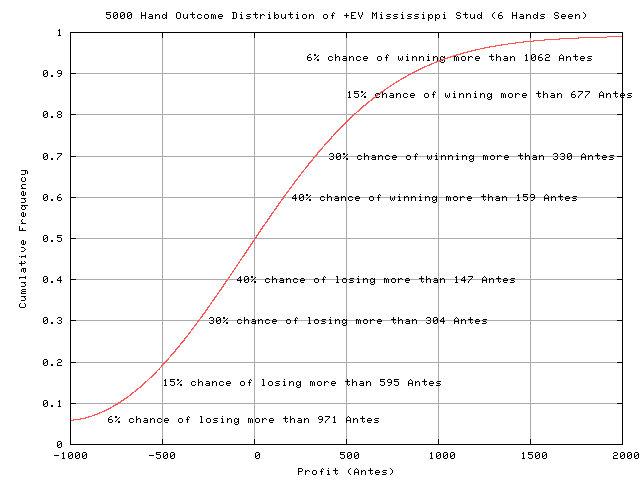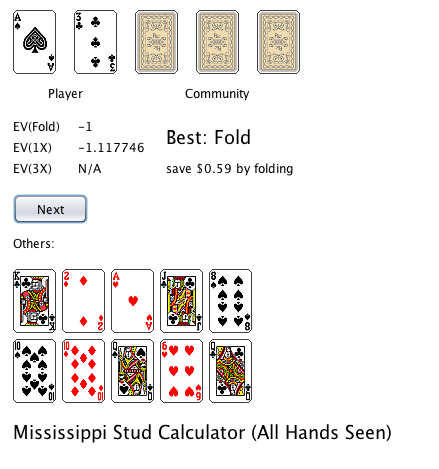Pai-Gow Tiles Tutorial
Last week I went to Vegas, and I mostly played $25 Pai-Gow Tiles. Over my 3 day trip, I played two hands of $5 UTH, two hands of $5 Crazy 4 Poker, one hand of $5 Texas Hold’Em Bonus, and maybe two dozen hands of $10 blackjack. Otherwise, I just played Pai-Gow tiles. It was the first time I played with a strategy, which I practiced on my trainer before the trip.
There were only a few other people that played the game. Often I was there by myself. The game isn’t hard to play, but there’s not a lot of beginner instruction out there, so it remains very mysterious to most people. So I made some video tutorials, to give people that jump-start to understanding the game. (Look for all my YouTube videos on Pai-Gow tiles.)
There’s a few reasons you should learn Pai-Gow tiles. First, it’s a lot of fun if you like games that require a little thought. Secondly, it’s a very cheap game. If you alternate hands as player and banker (e.g., when you’re heads up), the house edge is less than 1%. It even gets cheaper if the house doesn’t use quarters, and charges only $1 commission on a $25 win (4% commission). Finally, and perhaps most importantly, you get tons of degen “cred” by knowing this game well (especially if you’re lo-fan).
I played about 20 hours of $25 Pai-Gow Tiles at the MGM Grand, and got comp’ed for one night hotel stay (all I needed; my friend got comp’ed the other two nights), and I received $67 in cash comps towards our meals. Other than tokes, the average house vig came out to (20 hours)(30 hands/hour)($25/hand)(1%) = $150, which is about the value of my comps. I call that fair. Plus, I ended up winning on the trip, and came back with more money in my pocket than when I left.
Pai Gow Tile Practice Trainer
When I go with friends on 3-4 day trips to Vegas, I usually end up looking for a cheap game at some point during my 72 hours in the casino. Pai Gow Poker is cheap and slow, but it’s painfully boring. So the last few times we stayed at the Mirage, I started playing Pai Gow Tiles. I really like it now, because it’s a new game to learn, and I feel quite the degen pushing around the pretty little tiles.
The first times I played, I barely knew how to read a hand, and I didn’t learn any strategy. I often asked the dealer for the house way, which I later found out costs at least 0.5% compared to even a simple strategy. Besides, it’s much more fun to set your own hand (correctly). The Wizard of Odds has a very good calculator, but I still needed a practice trainer that taught a simple strategy.
So I wrote a trainer to teach myself, and other newbies, how to play the Wizard’s Simple Strategy. With some interactive practice, and just a little reading on the basics of the game, I hope that anyone can learn to play.
I wrote up a tutorial page on Pai Gow Tiles, if you need some background on the game.
Grinding Outcomes for +EV Mississippi Stud
In case you’re thinking about grinding out a profit at +EV Mississippi Stud (all 6 hands seen @ Barona), I’ve plotted an outcome distribution curve to show you what to expect. The following curve shows the cumulative outcome distribution of playing 5000 hands of Mississippi Stud at a fixed Ante, with a 1000 Ante bankroll. At a $5 Ante, this is a bankroll of $5000, and it would take a month of full-time play to see 5000 hands.
You can see the game is slightly in your favour, because of the asymmetrical bias towards bigger wins than losses. There’s a nice long tail of huge wins (although rare). On average, the expected win is (5000)(+1.25%) = 62.5 Antes. (This used a slightly older strategy; it could be improved.) However, there’s still a 6% chance of busting out, and you still have a 50% chance of losing after 5000 hands!
So, your +EV lies in the asymmetry of the curve, and the long tail of big wins. Not to mention that playing 5000 hands of normal (-EV) Mississippi Stud would cost you (5000)(-4.5%) = 225 Antes, and the outcome distribution curve would look much worse (I don’t have Basic Strategy coded up, but imagine the curve shifted higher and to the left.)
The best way to look at the face-up game is that it’s gambling with a tailwind. Anything can happen, but overall, you’ll feel the help of the tailwind, especially over the long run. Before I was barred, I really enjoyed playing the game hour-after-hour, week-after-week, because it all worked out in the end. It was like playing cards for free.
Mississippi Stud Calculator (All Hands Seen)
At my local Barona Casino, Mississippi Stud is dealt with all player hands face up. I’ve posted many times about the +EV strategy used with this information. No one at the tables plays optimally (i.e., no one listens to me), so the game still retains a huge house edge. In fact, the house edge is probably much higher at Barona, because players tend to play loose on 3rd Street (i.e., “see the first card”, or “always see the first card”) as long as they can see some outs, or some ways to make a hand. These 3rd Street mistakes range from 10% to 50% of the Ante, and are pure house edge. At casinos where players only see their own hand (not allowed to share info), they release losers more quickly, and tend to converge on correct basic strategy.
Of course, the only real advantage to seeing all the players cards is being able to fold early. The other advantage is knowing when to raise draws, but these are fairly rare (e.g., small pairs with all outs remaining on 3rd and 4th Streets, 6 high outs or 5 high suited outs on 3rd Street, certain straight draws on 5th Street). So folding early is the main use of the other player card info.
I wrote a Java calculator for Mississippi Stud when you can see all 6 player hands. It shows you the best decision at each point of the hand. (It’s a huge .jar file and may take some time to load, sorry.) Click on the screenshot below to try it:
The EV numbers tell you the expected value of the hand if you Fold, 1x, or 3x the bet for the next card. The EVs are normalized to the Ante, and a positive EV means an expected profit, and a negative EV means an expected loss. If you’re playing $5 Antes, then multiply these numbers by $5 for the value of the Fold, 1x, and 3x decisions.



leave a comment